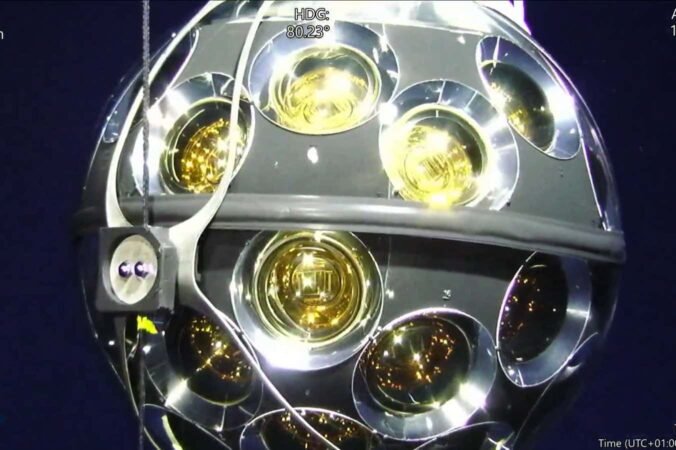Fast Facts
-
Record-Breaking Neutrino Discovery: Physicists observed an exceptionally powerful neutrino, with an energy of 120 peta-electron volts (PeV), using the KM3NeT neutrino telescope in the Mediterranean Sea, shattering previous energy records by tenfold.
-
Near Miss from Cosmic Origins: The detection occurred when KM3NeT was only 10% complete, and researchers had to rigorously account for background signals from cosmic rays, which traditionally overwhelm high-energy neutrinos by a billion to one.
-
Potential Cosmic Insights: The discovery opens avenues for understanding extreme cosmic phenomena, such as supermassive black hole mergers and supernova explosions, which are capable of producing high-energy neutrinos that can trace back to their origins in the universe.
- Future Detection Capabilities: With planned improvements to the KM3NeT telescope, scientists aim to enhance their ability to locate sources of similarly powerful neutrinos in the future, promising deeper insights into the universe’s most cataclysmic events.
Record-Breaking Neutrino Spotted in the Mediterranean Sea
Researchers have detected an extraordinary neutrino while operating a cutting-edge particle detector in the Mediterranean Sea. This neutrino, which broke previous energy records, has excited physicists and offers new insights into some of the universe’s most extreme events.
On February 13, 2023, the KM3NeT neutrino telescope, located at the bottom of the sea, picked up this powerful particle. Remarkably, the detector was only 10 percent complete at that time. Damien Dornic, a physicist at the Centre for Particle Physics in Marseille, expressed his team’s surprise. “First, we were confused. When we realized more and more that this event is truly exceptional, we were really excited,” he said.
Scientists often refer to neutrinos as "ghost particles." They travel through matter without much interaction due to their nearly massless nature and lack of electric charge. Thus, detectors must utilize massive volumes of material, like water or ice, to capture rare interactions. In this case, the neutrino collided with an atom, producing smaller particles called muons, which emitted light that the KM3NeT could detect.
The initial announcement of this discovery came in early 2024. At that stage, researchers were still measuring the neutrino’s exact energy level. They found that the neutrino carried an energy of 120 peta-electron volts (PeV), nearly ten times more than the previous record held by the IceCube Neutrino Observatory in Antarctica. This energy level far exceeds the most energetic particles generated in laboratory accelerators on Earth, such as the Large Hadron Collider.
Focusing on these kinds of high-energy neutrinos could lead to groundbreaking advancements in our understanding of cosmic phenomena. They emanate from processes like black hole formations or supernova explosions, which also generate cosmic rays that in turn produce more neutrinos. As Morgan Wascko from the University of Oxford points out, "Neutrinos will point straight back" to their sources, providing crucial directional information that other charged particles do not.
Despite the promising findings, researchers caution that tracing the neutrino’s origin remains challenging. The area it points to encompasses a large patch of space, complicating source identification. However, Dornic hopes that future improvements to the KM3NeT telescope will enhance their ability to pinpoint similar powerful neutrinos when they appear again.
As technology and techniques in neutrino detection progress, they could unlock new mysteries of the universe, deepening our understanding of cosmic events and potential breakthroughs in physics. Each discovery could fuel further advancements in technology and possibly inspire the next generation of scientists.
Discover More Technology Insights
Stay informed on the revolutionary breakthroughs in Quantum Computing research.
Explore past and present digital transformations on the Internet Archive.
SciV1

